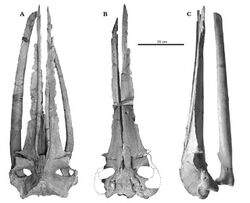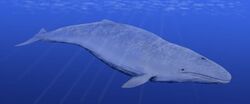Biology:Cetotherium
| Cetotherium | |
|---|---|
| Error creating thumbnail: Unable to save thumbnail to destination | |
| Mounted skeleton of Cetotherium riabinini | |
| Scientific classification | |
| Domain: | Eukaryota |
| Kingdom: | Animalia |
| Phylum: | Chordata |
| Class: | Mammalia |
| Order: | Artiodactyla |
| Infraorder: | Cetacea |
| Family: | Cetotheriidae |
| Subfamily: | †Cetotheriinae Whitmore & Barnes, 2008 |
| Genus: | †Cetotherium Brandt 1843 |
| Species[1] | |
|
†C. crassangulum Cope, 1895 | |
Cetotherium ("whale beast") is an extinct genus of baleen whales from the family Cetotheriidae.[2]
Taxonomy

The family Cetotheriidae and the genus Cetotherium (sensu lato) have been used as wastebaskets for all kinds of baleen whales, most notably by Brandt 1873, Spassky (1954) and Mčedlidze 1970. Based on more recent phylogenetic studies and revisions of many 19th century genera, much smaller monophyletic Cetotheriidae and Cetotherium sensu stricto is limited to a single or only a few species. For example, Gol'din, Startsev & Krakhmalnaya 2013 included only C. rathkii and C. riabinini in the genus and only ten genera in the family.[3]
Cetotheriidae were thought to have gone extinct during the Pliocene until 2012, when it was hypothesized that the pygmy right whale was the sole surviving species of this family.[4]
Formerly assigned to Cetotherium
The following species were originally described as nominal species of Cetotherium but have been either reassigned to other genera or removed from Cetotherium:
- Cetotherium furlongi Kellogg, 1925,[5] is known from a partial skull from the Burdigalian of the Vaqueros Formation in California , but the holotype is lost.[6]
- Cetotherium gastaldii Strobel, 1875,[7] known from the early Pliocene-age Sabbie d'Asti Formation of the Piedmont region in Italy, is now the type species of the eschrichtiid genus Eschrichtioides.[8]
- Cetotherium klinderi Brandt, 1871,[9] is known from an isolated earbone from Miocene sediments in Chişinău, Moldova. Although fragmentary, it is not congeneric with the two species of Cetotherium.[3][10]
- Cetotherium maicopicum Spasski, 1951,[11] based on a specimen from the late Miocene of the Russian Caucasus, was reassigned to the genus Kurdalagonus from the same region in 2012, although Gol'din and Startsev (2016) have questioned this referral.[12][10]
- Cetotherium mayeri Brandt, 1871,[9] known from a partial skeleton, has been reassigned to Mithridatocetus.[3][10]
Cetotherium incertum Brandt, 1873, known from a vertebra, and "Ziphius" priscus Eichwald, 1840 are nomina dubia, while Cetotherium pusillum Nordmann, 1860 requires re-assessment.[10]
Evolution

Cetotheres came into existence during the Oligocene epoch. The cetotheres have been divided into two sub-groups. One group includes Cetotherium. From evolutionary perspective, these whales share some characteristics of the Balaenopteridae and Eschrichtiidae.[13]
Paleobiology
Fossil records have revealed a predator-prey relationship between large sharks (e.g. O. megalodon) and Cetotheriids. The raptorial toothed whale, Livyatan melvillei, may too have posed a threat to these whales.[citation needed]
See also
- Evolution of Cetaceans
References
Notes
- ↑ "Classification of the family Cetotheriidae". Fossilwork. http://www.fossilworks.org/cgi-bin/bridge.pl?taxon_no=42973&action=taxonInfo.
- ↑ Berta & Deméré 2008
- ↑ 3.0 3.1 3.2 Gol'din, Startsev & Krakhmalnaya 2013, pp. 2, 4–6
- ↑ Fordyce, R. E.; Marx, F. G. (2013). "The pygmy right whale Caperea marginata: the last of the cetotheres". Proceedings of the Royal Society B: Biological Sciences 280 (1753): 1–6. doi:10.1098/rspb.2012.2645. PMID 23256199.
- ↑ R. Kellogg. 1925. Fossil cetotheres from California. Contributions to Palaeontology from the Carnegie Institution of Washington 348(2):35-56
- ↑ Kimura, T.; Hasegawa, Y. (2010). "A new baleen whale (Mysticeti: Cetotheriidae) from the earliest Late Miocene of Japan and a reconsideration of the phylogeny of Cetotheres". Journal of Vertebrate Paleontology 30 (2): 577–591. doi:10.1080/02724631003621912. Bibcode: 2010JVPal..30..577K.
- ↑ Strobel, P (1875). "Notizie preliminari su le Balenoptere fossili subappennine del Museo parmense" (in it). Bollettino del R. Comitato Geologico d'Italia 5 (6): 131–140.
- ↑ Bisconti, M (2008). "Morphology and phylogenetic relationships of a new eschrichtiid genus (Cetacea: Mysticeti) from the Early Pliocene of northern Italy". Zoological Journal of the Linnean Society 153: 161–186. doi:10.1111/j.1096-3642.2008.00374.x.
- ↑ 9.0 9.1 Brandt, J. F. 1871. Bericht uber den Fortgang meiner Studien uber di Cetaceen, welche das grosse zur Tertiarzeit von Mitteleuropa bis Centralasien hinein ausgedehnte Meeresbechen bevolkerten. Bulletin de l'Académie Impériale de Saint-Pétersbourg 16: 563–566.
- ↑ 10.0 10.1 10.2 10.3 Gol'din, Pavel; Startsev, Dmitry (2016). "A systematic review of cetothere baleen whales (Cetacea, Cetotheriidae) from the Late Miocene of Crimea and Caucasus, with a new genus". Papers in Palaeontology 3: 49–68. doi:10.1002/spp2.1066.
- ↑ P. I. Spasski. 1951. Ostaki tsetoheriev iz Servernogo Kavkaza (okr. g. Maikopa) Remains of cetotheria from the Northern Caucasus in the neighborhood of Maikop Town. Izvestia Akademii Nauk Azerbaidzhanskoi SSR 2:57-65
- ↑ Tarasenko, K. K.; Lopatin, A. V. (2012). "New Baleen Whale Genera (Cetacea, Mammalia) from the Miocene of the Northern Caucasus and Ciscaucasia: 1. Kurdalagonus gen. nov. from the Middle–Late Sarmatian of Adygea". Paleontological Journal 46 (5): 531–542. doi:10.1134/s0031030112050115.
- ↑ Kimura & Ozawa 2002
Sources
- Barry Cox, Colin Harrison, R.J.G. Savage, and Brian Gardiner. (1999): The Simon & Schuster Encyclopedia of Dinosaurs and Prehistoric Creatures: A Visual Who's Who of Prehistoric Life. Simon & Schuster.
- Berta, Annalisa; Deméré, Thomas (2008). "Mysticetes, Evolution". in Perrin, William F.; Würsig, Bernd; Thewissen, J. G. M.. Encyclopedia of Marine Mammals. Academic Press. pp. 751–752. ISBN 978-0-12-373553-9. http://www.bio.sdsu.edu/faculty/BERTA_files/Berta_Demere2009_Evolution.pdf.
- "De Cetotherio, novo Balaenarum familiae genere in Rossia meridionali ante aliquot annos effesso" (in fr). Bulletin de la Classe Physico-mathématique de l'Académie Impériale des Sciences de Saint-Pétersbourg 1 (10–12). 1843. https://archive.org/stream/bulletindelacla05naukgoog#page/n103/mode/2up. Retrieved 17 December 2021.
- Brandt, J. F. (1872). "Über eine neue Classification der Bartenwhale (Balaenoidea) mit Berücksichtigung der untergegangenen Gattungen derselben" (in de). Bulletin de l'Académie Impériale des Sciences de Saint-Pétersbourg. 3 17. https://www.biodiversitylibrary.org/item/27840#page/76/mode/2up. Retrieved 17 December 2021.
- Brandt, J. F. (1873). "Untersuchungen über die fossilen und subfossilen Cetaceen Europa's". Mémoires de l'Académie Impériale des Sciences de Saint-Pétersbourg. 7 20 (1): 1–372. https://archive.org/stream/untersuchungen00brandt#page/n11/mode/2up. Retrieved 17 December 2021.
- Gol'din, P.; Startsev, D.; Krakhmalnaya, T. (2013). "The anatomy of Cetotherium riabinini Hofstein, 1948, a baleen whale from the late Miocene of Ukraine". Acta Palaeontologica Polonica In press. doi:10.4202/app.2012.0107. https://deepblue.lib.umich.edu/bitstream/2027.42/102629/1/zoj12108.pdf.
- Kimura, Toshiyuki; Ozawa, Tomowo (2002). "A new cetothere (Cetacea: Mysticeti) from the early Miocene of Japan". Journal of Vertebrate Paleontology 22 (3): 684–702. doi:10.1671/0272-4634(2002)022[0684:anccmf2.0.co;2].
- (in ru, en) Some General Characteristics of the Evolution of Cetaceans, Part 1. Tbilisi: Akademia Nauk Gruzinskoi S.S.R. Institut Paleobiologii. 1970. OCLC 663053619. http://www.paleoglot.org/files/Mchedlidze%2070a.pdf. Retrieved 17 December 2021.
Wikidata ☰ Q478604 entry
 |

